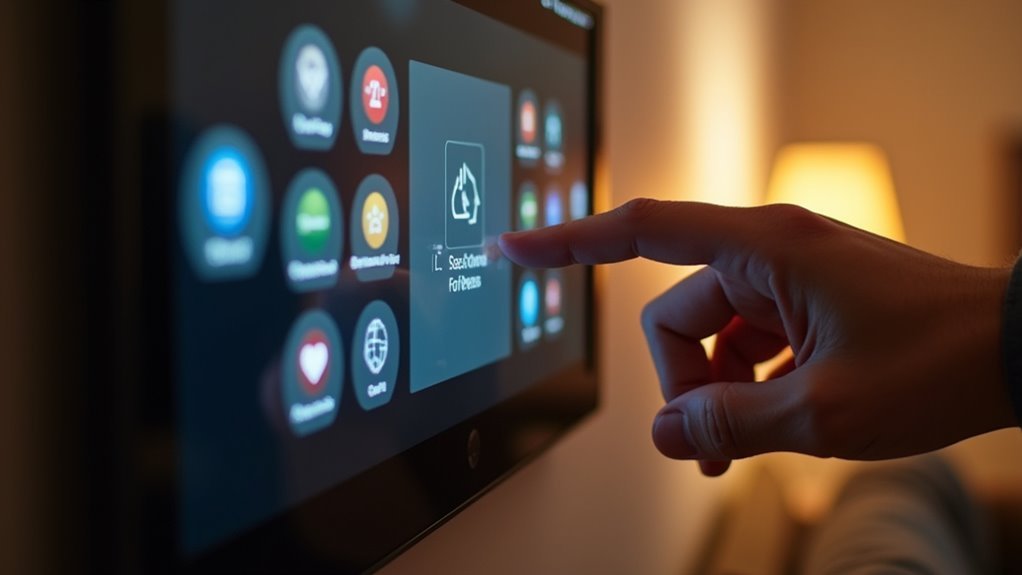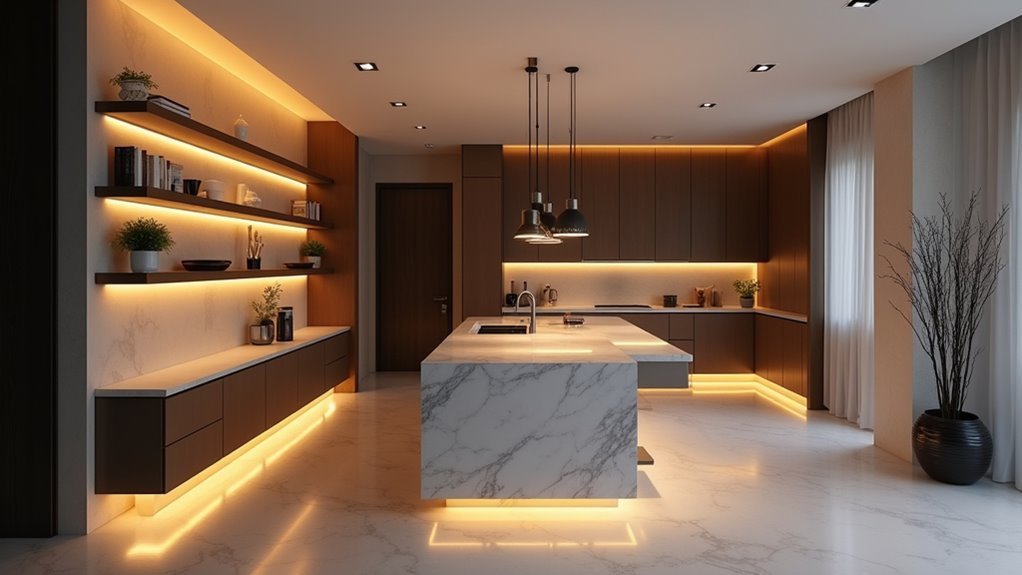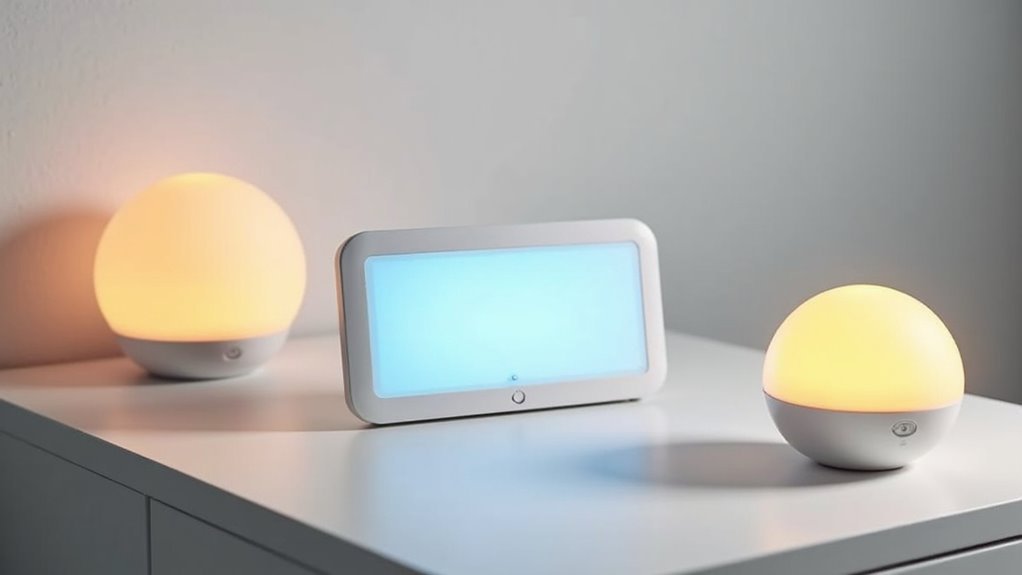When you’re setting up a home dashboard, you’ll quickly realize that true personalization isn’t just about choosing colors or rearranging widgets. It’s about creating a digital command center that actually reflects how you live, work, and interact with your space. The difference between a generic dashboard and one that feels genuinely yours lies in features that most people overlook—capabilities that transform your dashboard from a simple display into something far more intuitive.
Understanding the Core Elements of Personal Dashboard Software

When you’re exploring personal dashboard software, you’ll discover that customization sits at the heart of an effective system. Personal dashboards empower you to arrange widgets as data blocks that display metrics most relevant to your needs. You can prioritize information based on your preferences, creating a tailored view of what matters most.
Real-time updates guarantee you’re accessing the latest critical information for informed decision-making. Custom CSS capabilities let you modify visual elements, enhancing your user experience through personalized layouts and styling.
Personalization algorithms adapt content based on your behavior patterns, keeping your dashboard engaging and relevant. Alert systems and notifications for specific metrics maintain your engagement while keeping you informed about important changes, making your dashboard truly responsive to your individual requirements.
Customization Options That Define Individual User Experience
While personal dashboard software provides the foundation for data visualization, it’s the customization options that truly transform your experience from generic to genuinely personal.
These features empower you to create interfaces that align perfectly with your workflow and priorities. Your personal dashboard becomes truly yours through these key customization capabilities:
Transform your dashboard from a standard tool into a personalized command center that truly reflects your unique workflow and priorities.
- Drag-and-drop widget arrangement – Rearrange elements to prioritize information that matters most to you.
- Visual styling options – Choose themes, backgrounds, and custom CSS to reflect your aesthetic preferences.
- Smart alert configuration – Set notifications for specific metrics to stay informed about critical changes.
- Adaptive personalization algorithms – Software learns your behavior patterns to display increasingly relevant insights.
These customization options guarantee your dashboard evolves with your needs, maximizing both productivity and user satisfaction.
Integration Capabilities Across Multiple Smart Home Platforms

Beyond customization, your home dashboard software’s true power emerges through its ability to integrate seamlessly across multiple smart home platforms.
You’ll connect Zigbee devices, Tasmota switches, Sonos speakers, and Apple or Google Home assistants through one unified interface. This eliminates the frustration of jumping between separate apps.
Your personal dashboards become data powerhouses, pulling real-time information from connected devices to display energy consumption, security alerts, and system status updates.
You won’t just control lights—you’ll manage your entire digital ecosystem, including media services like Plex, Radarr, and Sonarr.
These robust integration capabilities guarantee your dashboard adapts as you add new technologies.
You’re building a system that grows with your smart home, maintaining seamless connectivity across evolving platforms and services.
Real-Time Data Visualization and Display Preferences
You’ll want your home dashboard to display live data from your smart devices in formats that make sense for your lifestyle.
The software should let you customize chart types, colors, and layouts while pulling real-time information from sensors, thermostats, and other connected systems.
Your dashboard becomes truly useful when you can configure personalized widgets that highlight the metrics you check most often.
Live Data Integration Methods
Since modern home dashboard software depends on continuous data flow to remain relevant, you’ll need robust integration methods that can pull information from multiple sources without creating system bottlenecks.
Several proven approaches enable seamless live data integration for real-time data visualization:
- RESTful APIs – Connect directly to smart home devices, weather services, and financial platforms for automatic updates without manual refreshing.
- System monitoring tools – Use Telegraf or Prometheus to collect CPU, RAM, and network metrics that dashboards make visible instantly.
- HTML iframes – Embed external content like weather widgets or media player status displays without complex database configurations.
- Web scrapers – Automate collection of billing information and financial data to keep important notifications current.
These methods guarantee your dashboard maintains accurate, up-to-date information while preserving system performance and user experience.
Visual Chart Customization Options
Effective home dashboard software transforms raw data streams into meaningful visual insights through extensive chart customization options. You can choose from various chart types including bar graphs, line charts, and pie charts to represent your real-time data effectively.
The software lets you customize visual elements like colors, sizes, and styles to enhance readability and clarity of your displayed metrics.
You’ll appreciate the drag-and-drop functionality that allows you to arrange components according to your preferences. Personalization options enable you to filter out irrelevant information, focusing on metrics that matter most to your unique circumstances.
These customization capabilities guarantee your dashboard layout aligns with your specific needs while maintaining ideal engagement levels.
Personal Widget Configuration Tools
While basic chart customization provides a solid foundation, personal widget configuration tools elevate your dashboard experience by offering granular control over individual data components.
These tools transform your Home Assistant interface into a truly personalized command center that adapts to your specific needs.
Personal widget configuration empowers you to:
- Add and rearrange widgets instantly through drag-and-drop functionality, creating layouts that match your workflow
- Select from diverse widget types including graphs, charts, and summary blocks to display data in your preferred format
- Apply intelligent filtering options to exclude irrelevant information and focus on what matters most
- Benefit from personalization algorithms that learn your behavior patterns and automatically prioritize valuable insights
Your dashboards become uniquely yours, reflecting your monitoring priorities perfectly.
User Interface Design and Layout Flexibility
You’ll want your home dashboard to adapt to your unique needs and preferences through intuitive design features.
Drag-and-drop widget customization lets you arrange your dashboard elements exactly where you want them, creating a personalized layout that matches your workflow.
Responsive multi-device layouts guarantee your dashboard works seamlessly whether you’re checking it on your phone, tablet, or computer screen.
Drag-and-Drop Widget Customization
When setting up your home dashboard, drag-and-drop widget customization transforms what could be a complex technical process into an intuitive experience that takes just minutes to complete.
This drag-and-drop functionality eliminates the need for coding skills while empowering you to create a truly personalized interface.
Widget customization enhances your dashboard in four key ways:
- Effortless Rearrangement – Simply click and drag widgets to reorganize your layout according to your preferences.
- Quick Widget Addition – Add new service tiles instantly to adapt your dashboard to changing needs.
- Priority-Based Display – Curate information that’s most relevant to your daily workflows.
- Enhanced Ownership – Take control of your interface design without technical barriers.
This intuitive approach boosts user engagement by making your dashboard align perfectly with your personal objectives and work habits.
Responsive Multi-Device Layouts
Once you’ve arranged your widgets perfectly, responsive multi-device layouts guarantee your customized dashboard delivers the same intuitive experience whether you’re checking your smart home status on a desktop computer, tablet, or smartphone.
This responsive design automatically adapts elements to different screen sizes, ensuring buttons remain touchable and information stays readable across all devices.
Your dashboard maintains essential functionality regardless of whether you’re using mouse clicks or touch gestures.
The multi-device optimization means you’ll control smart home devices and monitor key metrics on-the-go without compromising usability.
Elements resize and reposition intelligently, creating consistent navigation patterns that reduce your learning curve.
This seamless user experience across multiple platforms greatly improves engagement by accommodating your varying preferences and workflows throughout different environments.
Device Control and Automation Features

While traditional home automation required separate apps for each device, modern home dashboard software consolidates control into a single, intuitive interface that lets you manage lights, thermostats, security systems, and countless other smart devices from one centralized hub.
The device control capabilities transform how you interact with your smart home environment.
Automation features elevate convenience through intelligent scheduling and trigger-based responses:
- Schedule-based automation turns lights on at sunset and adjusts thermostats when you’re away
- Voice assistant integration with Alexa and Google Assistant enables hands-free device management
- Customizable alerts notify you when security cameras detect motion or energy consumption spikes
- Real-time energy monitoring helps optimize device settings for improved efficiency and reduced costs
These features create a truly personalized experience that adapts to your lifestyle.
Data Source Management and Connectivity
Your connectivity options include Zigbee, Tasmota, and SNMP protocols, enabling seamless device communication and real-time data flow.
RESTful APIs guarantee continuous refresh cycles, delivering live updates that keep your metrics current for informed decision-making.
Tools like Telegraf and Varken collect system performance data, while custom web scrapers track billing amounts and due dates from service providers.
This integrated approach means you’re not just viewing isolated data points—you’re accessing a unified ecosystem that reflects your home’s complete operational status.
Personalized Notification and Alert Systems
Beyond simply displaying data, effective home dashboard software transforms raw metrics into actionable intelligence through personalized notification and alert systems.
You’ll receive timely updates that matter most to your specific needs and routines. These systems leverage real-time data to keep you informed without overwhelming you:
- Custom alerts for critical events like security breaches, device malfunctions, or air quality changes
- Smart filtering options that exclude irrelevant notifications while highlighting priority information
- Behavioral adaptation that learns your patterns to deliver reminders at ideal times
- Personalized alerts for routine tasks like bill payments or maintenance schedules
Your dashboard becomes more than a monitoring tool—it’s an intelligent assistant that anticipates your needs and responds instantly to changing conditions in your home environment.
Responsive Design for Multi-Device Access
You need your home dashboard to work flawlessly whether you’re checking it on your phone while away or using your tablet in the living room.
Cross-platform layout optimization guarantees your interface automatically adjusts to each screen size, while touch-friendly elements make navigation intuitive on any device.
When you switch between devices, you’ll experience seamless continuity that lets you pick up exactly where you left off.
Cross-Platform Layout Optimization
When users access your home dashboard software from different devices throughout their day, responsive design becomes the foundation that guarantees consistent functionality and visual appeal.
Cross-platform optimization guarantees your dashboard adapts flawlessly whether you’re checking metrics on your smartphone during lunch or reviewing detailed analytics on your desktop at home.
Effective layout optimization enhances user experience through:
- Adaptive grid systems that reorganize content based on screen dimensions while maintaining visual hierarchy
- Touch-friendly interfaces optimized for tablets and smartphones with appropriately sized buttons and navigation elements
- Prioritized content display that emphasizes critical metrics on smaller screens while expanding details on larger displays
- Consistent navigation patterns that remain familiar across all devices, reducing learning curves and increasing efficiency
This seamless adaptation keeps you engaged regardless of your chosen platform.
Touch-Friendly Interface Elements
Modern touch interfaces demand carefully calibrated design elements that respond intuitively to finger interactions rather than precise mouse clicks.
You’ll need larger buttons, generous spacing between controls, and swipe-enabled navigation to create an effective touch-friendly interface that works seamlessly across devices.
Your dashboard’s responsive design should automatically adjust element sizes based on screen dimensions.
When you’re checking temperatures on your phone versus controlling lighting from your tablet, the interface adapts appropriately.
Larger touch targets prevent accidental selections, while gesture-based controls like swiping through room settings enhance your interaction experience.
Multi-device access becomes truly effective when your dashboard maintains consistent functionality whether you’re using a smartphone during your commute or a tablet at home.
This consistency guarantees you’ll navigate confidently from any device, creating a genuinely personalized experience.
Seamless Device Switching
Since your daily routine involves switching between multiple devices throughout the day, your home dashboard’s responsive design becomes the foundation for maintaining uninterrupted control over your smart home ecosystem.
Whether you’re checking your security cameras on your smartphone during lunch or adjusting your thermostat from your tablet in bed, seamless device switching guarantees continuity in your user experience.
Your dashboard’s adaptive design provides:
- Instant synchronization across all devices, maintaining your current session and settings
- Optimized layouts that automatically adjust interface elements for each screen size
- Consistent functionality guaranteeing all features remain accessible regardless of device
- Real-time updates that reflect changes immediately across your connected devices
This responsive design eliminates the frustration of relearning interfaces, making your smart home truly accessible anywhere, anytime.
Security and Privacy Controls for Home Networks
Three fundamental layers of protection form the backbone of any secure home network: authentication controls, data encryption, and continuous monitoring.
Your security starts with robust user authentication mechanisms like OIDC or LDAP, which prevent unauthorized access while maintaining convenient shared access for family members. These privacy controls let you assign specific roles and permissions, ensuring roommates can use shared devices without accessing your sensitive information.
Strong encryption protocols safeguard all data transmission between your smart devices, protecting your personal information from potential interceptors.
You’ll need to maintain regular firmware updates on routers and connected devices, as these contain critical security patches against emerging vulnerabilities.
Network monitoring tools provide real-time detection of unusual activity, enabling you to respond immediately when threats emerge and maintain your home’s digital privacy.
Widget Configuration and Dashboard Modules
You can effortlessly arrange your dashboard by dragging and dropping widgets exactly where you want them, creating a layout that matches your daily routine and priorities.
Real-time data modules continuously update information from your connected devices, ensuring you’re always viewing current statistics for everything from energy consumption to security alerts.
Custom CSS styling lets you personalize the visual appearance of each widget, allowing you to adjust colors, fonts, and layouts to create a dashboard that’s both functional and visually appealing.
Drag-and-Drop Widget Placement
When you’re setting up your home dashboard, drag-and-drop widget placement transforms what could be a complex configuration process into an intuitive experience that requires zero coding skills.
You can effortlessly rearrange your dashboard layout to match your specific needs and workflow preferences.
This powerful customization approach offers several key advantages:
- Instant service integration – Add new tiles with just a few clicks to expand your dashboard’s functionality
- Visual personalization – Choose from various themes, icons, and styles to create your unique aesthetic
- Prioritized organization – Arrange essential metrics at the top for streamlined access and improved productivity
- Unlimited scalability – Incorporate countless widgets for weather, device controls, financial tracking, and more
The drag-and-drop interface guarantees your dashboard evolves with your changing needs.
Real-Time Data Modules
How effectively can your dashboard serve you without access to live, actionable data? Real-time data modules transform your home dashboard from a static display into a dynamic control center.
These customizable widgets let you monitor critical metrics like air quality, temperature, energy consumption, and device status instantly. You can filter and arrange these modules based on your preferences, creating a personalized dashboard that prioritizes information most relevant to your daily routines.
Your dashboard integrates multiple data sources, providing extensive visibility into your home’s operations. You’ll make informed decisions when you have immediate access to fluctuating metrics.
Set up customizable alerts within widget configurations to receive notifications about critical changes, contract renewals, or significant variations in monitored data, ensuring you’re always informed about your home environment.
Custom CSS Styling
Although real-time data provides the foundation for effective home monitoring, custom CSS styling transforms your dashboard’s visual identity to match your personal aesthetic preferences.
You’ll have complete control over themes, background images, and tile icons, creating truly unique interfaces that reflect your style.
Personalizing your dashboard becomes effortless with these styling capabilities:
- Theme customization – Apply custom CSS to create minimalist or elaborate retro designs
- Widget-specific styling – Adjust individual module layouts and appearances for enhanced visual appeal
- Built-in icon library – Access thousands of icons without requiring advanced design skills
- Background personalization – Add custom images and color schemes that match your preferences
Custom CSS guarantees your dashboard isn’t just functional—it’s visually engaging and perfectly tailored to your unique needs.
Performance Optimization for Home Hardware
Since home dashboard systems often run on budget-friendly hardware like Raspberry Pi devices, you’ll need to optimize performance carefully to achieve responsive operation.
Performance optimization starts with choosing lightweight frameworks like Next.js and Tailwind CSS, which guarantee smooth operation without sacrificing functionality on low-end devices.
You should regularly update your router firmware and device software to enhance security and integration capabilities.
Monitor system metrics using tools like Telegraf to track CPU and RAM usage, helping you identify bottlenecks before they impact performance.
Configure automatic application restarts after system reboots to maintain continuous operation without manual intervention.
These optimization strategies will markedly reduce latency and improve response times, creating a seamless dashboard experience even on budget hardware.
Scalability and Future-Proofing Considerations
Building an efficient home dashboard represents just the beginning of your smart home journey. Your system needs scalability to accommodate growing device networks and evolving requirements without complete overhauls.
Your smart home dashboard is merely the foundation—true success lies in building a system that evolves with your expanding digital ecosystem.
Future-proofing demands strategic planning around emerging technologies. Consider these essential elements:
- Modular Architecture – Choose platforms supporting component upgrades without disrupting existing functionality.
- Protocol Compatibility – Guarantee support for Zigbee, Z-Wave, and other standards to accommodate diverse manufacturers.
- Active Development – Select software with regular updates and strong community support for emerging tech compatibility.
- Cloud Integration – Implement cloud-based solutions for remote access and seamless third-party service integration.
These considerations guarantee your dashboard adapts as technology advances, protecting your investment while maintaining peak performance across your expanding smart home ecosystem.
Community Support and Development Resources
When you’re selecting home dashboard software, the strength of its community and available development resources can make or break your experience. Active forums and discussion groups provide invaluable community support where you’ll find troubleshooting help, customization tips, and creative solutions from fellow users.
Extensive documentation, tutorials, and guides serve as essential development resources that’ll accelerate your learning curve and optimization efforts. You’ll benefit from platforms with active GitHub repositories, enabling direct contributions and feature requests.
Regular hackathons foster innovation and expand functionality options. Don’t overlook the wealth of user-generated content available through blogs and video tutorials—these resources often contain the most practical insights for maximizing your dashboard’s potential and achieving truly personalized setups.
Frequently Asked Questions
What Is a Personal Dashboard?
A personal dashboard is your customizable interface that aggregates relevant information tailored to your specific needs. You’ll see data from various sources like smart home metrics, finances, and projects in one accessible location.
What Are the Characteristics of a Good Dashboard?
You’ll want dashboards that prioritize simplicity and essential metrics. They should use effective visualizations, establish clear information hierarchy through size and color, guarantee responsive design across devices, and offer personalization features for your specific needs.
Why Are People Obsessed With Dashboards?
You’re obsessed with dashboards because they give you instant control over your data, letting you visualize complex information at a glance while tracking what matters most to you personally and professionally.
What Makes a Dashboard Interactive?
You’ll find dashboards interactive when they let you manipulate data through customizable widgets, receive real-time updates, integrate with other tools, personalize layouts, and engage with visual elements like charts and graphs.





Leave a Reply